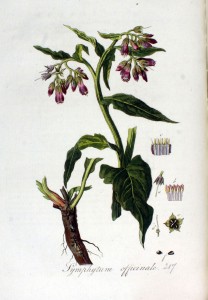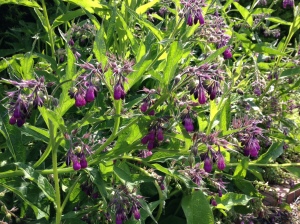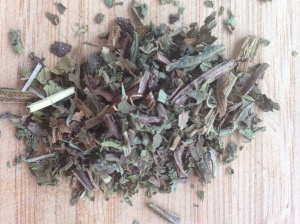Symphytum officinalis Common name: Comfrey
Family: Boraginaceae
Part Used: Root (external only) & Leaves
Constituents: Alkaloid (pyrrolizidine) (root only), mucilage, gum, tannin, triterpenes (sitosterols, stigmasterol, steroidal saponins), silicic acid, phenolic acid (caffeic, rosmarinic, chlorogenic), allantoin, asparagine, choline, chlorophyll (higher in leaves, Ca, K+, P, trace minerals, vitamins A and C).
Medicinal actions: Anti-hemorrhagic, anti-inflammatory, astringent, expectorant, anti-rheumatic, cell-proliferant, vulnerary,demulcent, hemostatic, cell proliferant (root), wound/tissue healer, bone healer

Medicinal use: Internal use of Symphytum is indicated in the treatment of diarrhea and dysentery, and shallow G.I. ulcers. These conditions respond to the demulcent, vulnerary, astringent, antihemorrhagic, and anti-inflammatory properties of the plant. The astringent action of Symphytum also reduces hemorrhage associated with uclers and colitis. Bronchial irritation and irritated coughs with hemoptysis respond well. External use of Symphytum is well indicated for a variety of conditions such as sore muscles, bone fractures, sprains, ligament tears and any damage to aching joints.
Pharmacology:
- Phenolic acid rosmarinic is anti-inflammatory.
- Allantoin promotes wound healing through cell proliferation and is anti-inflammatory.
- Pyrrolizidine alkaloids are hepato-toxic and carcinogenic.
- Silicic acid helps preserve elasticity of connective tissue, controls Ca+ absorption and is needed for bone and cartilage formation.
Pharmacy: Infusion (leaves) 5 g/cup, TID. Decoction: 5 g/cup, TID. Cold extraction (mucilage). Tincture: (1:5, 25%), 2-4 ml TID. Fluid extract: (1:1, 25%) 1-3 ml TID. Ointment, Cream, Lotion, Fomentation, Compresses, Poultices, Washes, Baths. Note: Short-term dosing (2-3 weeks on and 2-3 weeks off – repeat as needed). If using for longer than 2 months test liver enzymes and question whether this is the best herb to use.

Toxicity: Alkaloids have been shown to cause veno-occlusive disease of the liver (one documented human case and in rats).
Note: The current debate about whether to use Symphytum internally is due to concern over the pyrrolizidine alkaloids, specifically the echimidine alkaloid found primarily in the root. Toxicity reports are based on isolated compounds, not on the whole plant usage. The plant has centuries of use with beneficial results.
Contraindications: Internal use in liver disease, pregnancy & lactation, or in infants. Use on dirty skin or deep wounds (surface may heal too fast trapping dirt and pus).
Interactions: None reported.


Discussion
Comments are closed.